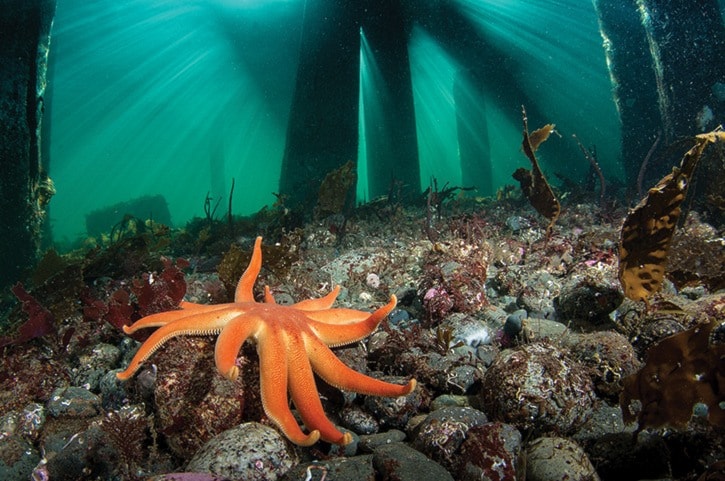As a mysterious disease lays waste to sea stars along the continental coast, populations in the waters around Campbell River and the Discovery Islands still appear robust and healthy.
“Knock on wood, it isn’t here yet,” says dive instructor Dylan Smith of Beaver Aquatics.
The strange condition was first seen in B.C. waters last September, in and around Howe Sound, where divers witnessed once-healthy sea stars quickly break down and dissolve into white goo in a matter of days.
Since then the condition, dubbed Sea Star Wasting Syndrome, has been seen off the waters in Southern California and as far north as Alaska.
It’s also been documented north of the city in Johnson Strait, near Port Hardy and Telegraph Cove.
“The most valuable thing to admit right now is that we don’t know everything…and we’re trying to understand what is happening,” says Jackie Hildering of Port McNeill who runs the educational website www.themarinedetective.com
While diving around Beaver Cove, near Port Hardy, last December, Hildering photographed at least four species of sea stars with the wasting syndrome.
Over a matter of days, they slowly decayed, but it wasn’t at the same rate which is happening to sea stars in Howe Sound whose populations have been decimated.
In a time-lapse video (www.youtube.com/watch?v=mjrp3Eckr-E&feature=youtu.be) taken over eight hours, a sea star in a tank at the Vancouver Aquarium swims around until most of its arms drop off.
“It’s creepy,” admits Hildering, “but up here (North Island) it doesn’t seem to have the same virulence. Maybe we have less stressors?”
Marine scientists are trying to determine the cause, but that’s enormously difficult to do when the sea stars die and decay so rapidly.
Researchers at the Vancouver Aquarium, the University of California Santa Cruz and Cornel University in New York State are among the think-tanks actively involved in the search for the reason for the decay, but they also need the public’s help.
“We have huge gaps in observation,” says Hildering. “We need ‘citizen science’ to help us know what’s going on…this is a massive geographic effort.”
Underwater photographer Eiko Jones and Smith regularly dive around Campbell River and the Discovery Islands, and are among the citizen scientists keeping close watch on local sea stars populations which appear as abundant as ever.
“Everything looks healthy. No sign of wasting,” says Jones, who dives 2-3 times a week with Smith.
Like the syndrome itself, no one knows why local sea stars appear unaffected, but there’s always speculation.
“I can only believe it’s because of the currents,” says Smith.
Hildering also went diving with Smith last month and was pleasantly surprised to see loads of healthy sea stars.
However, she urges the public to keep a close watch on the shorelines, particularly at low tides, and report any possible findings and photographs of Sea Star Wasting Syndrome to the Vancouver Aquarium (www.vanaqua.org/act/research/sea-stars).
The website has a map showing where sea star populations have been hit along the B.C. coast, but a more complete map of the Canadian and American west coast is found on the University of California Santa Cruz website (www.eeb.ucsc.edu).
Hildering is hopeful the two groups combine their data and the mapping, and she urges local residents to report their observations to the Vancouver Aquarium to get a “better picture” of sea star health on the B.C. coast.
“It’s important for the public to share their observations,” she said.
Fast Facts
- Sea stars are more abundant and diverse in our waters than anywhere else in the world, according to the Vancouver Aquarium.
- Sea stars appeared to be over-abundant throughout the Strait of Georgia, but divers began noticing sick and dying stars in early September 2013.
- The phenomenon seems to be affecting a number of species including purple stars, pink stars, mottled stars and several others. However, the sunflower star appears to be the hardest hit species, with dense aggregations disappearing in a matter of weeks.
- When sea stars are affected white lesions appear on an animal. Within hours or days the sea star becomes limp and its arms may fall off. Necrosis eventually takes over and the animal dies.
